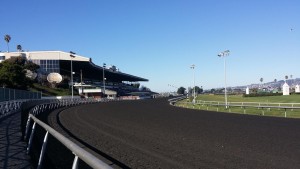
When synthetic tracks were first put on the agenda in the US a few years ago, the debate and opposition amongst trainers, owners, bettors and racing fans raged long and hard. Feelings ran high. Traditionalists favored the dirt track surface that they were familiar with, over a synthetic track that they were not. Yet the hard evidence of the massively increased safety of synthetic tracks was already on the table for all to see, even then. Ireland, the UK and France had installed multiple synthetic tracks 20 years previously. Synthetic tracks’ safety records for horses and riders were spectacular, but many US horsemen simply did not want to hear it. (If anyone seriously doubts now after several years of solid statistics and records, that synthetic tracks are not significantly safer for horses than dirt tracks, I would be happy to introduce them to a good psychiatrist.)
A few years on, Santa Anita and Keeneland made the decision to take out their synthetic tracks and go back to dirt. The installation of Santa Anita’s synthetic surface was questionably managed, as was its maintenance program. Keeneland – well that’s another story… But it was a sad day for the horses at both venues.
 Other tracks however have now realized what a boon their racing synthetic tracks truly are. Woodbine, Turfway Park, Presque Isle Downs and Golden Gate Fields horsemen, many of whom were previously die hard dirt track protagonists, now fully embrace the synthetic surfaces and love training and racing over them.
Other tracks however have now realized what a boon their racing synthetic tracks truly are. Woodbine, Turfway Park, Presque Isle Downs and Golden Gate Fields horsemen, many of whom were previously die hard dirt track protagonists, now fully embrace the synthetic surfaces and love training and racing over them.
They know their horses are enjoying the surface. They know their horses are in better shape. They know they are seeing far fewer catastrophic career ending injuries. They know their horses are sounder and are generally able to run more often. They know their barns are fuller, and business is better, as a result of the synthetic surface.
What horsemen actually objected to when California mandated to switch all their tracks from dirt to synthetic, was that they were being told that they had to replace the one with the other. If the mandate had been to install synthetic tracks in addition to the existing dirt tracks, rather than instead of them, it is a fair bet that curiosity and interest would have replaced fear and angst, as the dirt tracks were not being taken away. Unfortunately, space and existing racetrack layouts scuppered that possibility. It had to be one surface, or the other.
The next racetrack built in the USA, whenever it comes, will hopefully have enough space that it can be designed differently to current tracks, thus enabling three different surfaces for owners and trainers to run and train their horses on. Ideally it will also be a bigger set of ovals, as most horsemen agree that at speed, gradual turns are kinder to horses than tighter ones. Perhaps it would look like this.
1) A mile and an eighth inner dirt track.
2) A mile and a quarter turf track.
3) A mile and a half synthetic (Tapeta please) track.
The three tracks should also be equipped with chutes to enable flexibility in the distance of their races.
Possible? Of course. Good news? How could it not be? A solution that appeases all comers by giving horsemen the option of running their horses on the surface that they prefer, or/and which suits their individual horses best.
And how interesting it would be to see, over time, which surface becomes the most popular for both training and racing. And to see which surface produces the biggest field sizes, the most entertaining races and the strongest betting handle.
My bet is that Tapeta would come out on top, followed closely by Turf, with Dirt a distant third.
-Carl Wilson